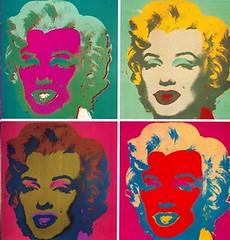It was during the 1960s that Warhol began to make paintings of iconic American products such as Campbell's Soup Cans and Coca-Cola bottles, says Wikipedia, as well as paintings of celebrities such as Marilyn Monroe, Elvis Presley, Muhammad Ali and Elizabeth Taylor.
His Manhattan studio in the 60's was large and called The Factory. He gathered a wide range of artists, writers, musicians, and underground characters.
Into mechanical reproduction of art, he began producing prints using the silkscreen method.
His work became popular in the early 60's. It was also deemed commercial, "a sell-out!" and thus controversial.
Among the Warhol images (mostly based on clippings from newspapers) were dollar bills, celebrities and brand name products such as Brillo boxes.
He also used newspaper headlines and photos of mushroom clouds, electric chairs, and police dogs attacking civil rights protesters.
Warhol also used Coca Cola bottles as subject matter for paintings. He had this to say about Coca Cola:
What's great about this country is that America started the tradition where the richest consumers buy essentially the same things as the poorest. You can be watching TV and see Coca Cola, and you know that the President drinks Coca Cola, Liz Taylor drinks Coca Cola, and just think, you can drink Coca Cola, too. A coke is a coke and no amount of money can get you a better coke than the one the bum on the corner is drinking. All the cokes are the same and all the cokes are good. Liz Taylor knows it, the President knows it, the bum knows it, and you know it.[10]
New York's Museum of Modern Art hosted a Symposium on pop art in December 1962 during which artists like Warhol were attacked for "capitulating" to consumerism. Critics were scandalized by Warhol's open embrace of market culture. This symposium set the tone for Warhol's reception.
Throughout the decade it became more and more clear that there had been a profound change in the culture of the art world, and that Warhol was at the center of that shift.
Tuesday, February 5, 2013
Subscribe to:
Post Comments (Atom)





No comments:
Post a Comment